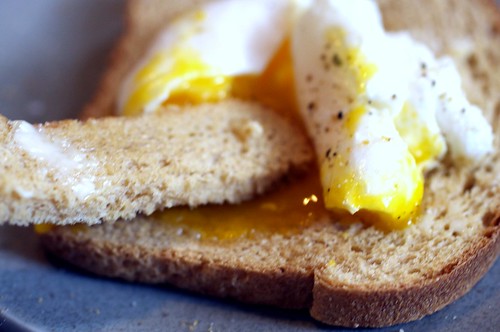I have taken a long break from the blog, but I am returning to bring you more useful tips, info and techniques to help you develop your inner cook.
Today will be something of a two-for-one deal, probably because its a Monday at the end of the month, when money's getting tight in expectation of the budget hit when rent comes due in a few days. So we're going to look at a nice technique that will make a good impression and will allow you to open a new branch of flavors in your meals: poaching.
First off, a definition: poaching is a cooking term that means slowly cooking in liquid. Its not boiling, as poaching requires a much lower level of heat, and the liquid used will often not turn into a sauce. Its a more delicate technique, but that can result in very interesting results.
The most common poached food you might have come in contact with is poached eggs, especially in the posh breakfast staple, egg benedictine. Poached eggs are an easy way to learn the basics, and cheap to: all you need is a cooking vessel, either a sauce pan or a frying pan deep enough to hold the cooking liquid and the egg, water, an acid flavouring agent (good vinegar or lemon juice) and an egg of two. A ramekin comes in handy to manage the pouring on the egg.
Fill the vessel with water and add about a spoonful of your acid agent. Bring to a very light simmer, making sure you not only not boil the water, but just enough that you can see a very gentle roll in the liquid. Crack the egg in the ramekin, being careful to keep the yolk whole. Pour the egg gently into the water, then cover and turn off the heat; this will prevent the whites from cooking too tough at the bottom. Let stand, undisturbed for three minutes, then remove using a slotted spoon. The white should be just set enough to keep it together and the yolk should be barely set on the edges but runny.
Its an easy, no-mess way of preparing your eggs in the morning, keeping the scent of cooking food to a minimum. Also, its a delicious way to impress that date you brought home last night and that stayed over for breakfast.
Some now you know how to poach eggs; the same basic technique can be used for other, more delicate foods, like fish, chicken, or fruits, using different cooking liquids.
Now, here's my favourite poached preparation, poached onions, or onion confit.
The idea is the same, but the items are cooked in this fashion more as a preservation method. The start example of this is duck or goose confit, originally from south western France, where the birds and cut into pieces, cured, and then poached into cooking fat, usually their own. The parts are then put into jars that are then filled to cover with the cooking fat to seal. The preparations can then keep for long periods with minimal refrigeration.
In Italy and southern France, condiments like onions, garlic and chilies. The preparation is very simple, if a little time-consuming, definitely something of the "slow food" movement. The basic elements required for this is a thick frying pan, olive oil and onions. Simple.
First, thinly slice your onions. Just half and slice, keep it simple. Then, put a good amount of olive oil in the pan a bring to a low heat, basically medium-low, edging towards the low side; you don want to fry your onions, just heat them in the oil. When you're confident that oil is at the right temperature, add the slices, and stir to ensure that everything is spread out. There should be plenty of oil, as it acts as the poaching medium. I like to add a bit of thinly sliced or crushed garlic to the mix, for flavor and to balance the chemistry, and a pinch or two of kosher salt to help the onions sweat. A few drops of balsamic vinegar, some herbs (oregano, rosemary and thyme work well), a touch of sugar also can help you shape the flavors.
This will need to cook for a good forty-five minutes, stirring occasionally. Adjust the heat as needed to avoid the crusting at the bottom of the pan. It is ready when the onions nearly disintegrate. You want a very soft mixture. Take off from the heat and use.
It makes a great alternative to tomato sauce in pizza and pasta, and its a great way to build a base for a ragout or stew sauce. And its a perfect base for our next blog entry, gumbo!



No comments:
Post a Comment